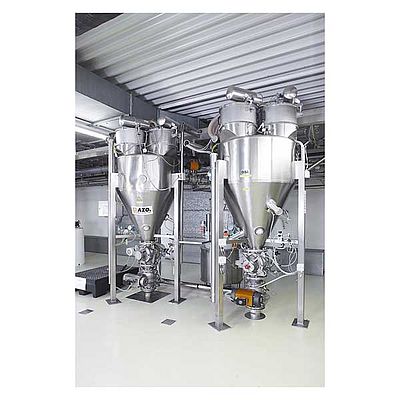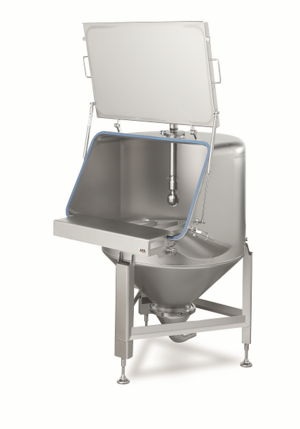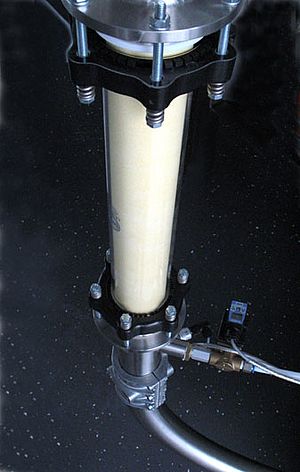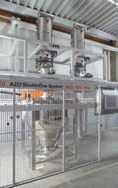Conveying methods for bulk goods are as varied as the material itself. Depending on the structure, moist content, abrasiveness and many other properties the appropriate conveying system should be chosen.
Simple feeding systems
Classic method of pneumatic conveying. For feeding of packing and injection moulding machines, dryers, mills as well as containers, tanks and silos. Bulk materials can be fed from nearly all kinds of packaging such as sacks, barrels, containers etc. From the bulk goods feeding point, a partial vacuum causes the conveyed product to be sucked into a receiver where it is then separated. After each conveying interval, the filter is automatically cleaned off by means of compressed air impulses. All systems are ready for connection, fitted with the latest electronic control systems and signal when there is no longer sufficient bulk material at the feeding point.
When product is to be conveyed to several processing machines, centralised feeding with only one common vacuum generator is recommended. The electronic control system scans demand in turn and switches the appropriate receiver to suction mode by means of an angle valve. As soon as the full-signalling device in the receiver responds, conveying is ended.
Vacuum pneumatic dense-phase conveying systems
The most gentle method of pneumatic conveying is especially suitable for continuous feeding with moist, fat-containing bulk materials that tend to stick together or with delicate grain structures as well as for conveying very of fine or light products.
At the product feeding point the conveyed product is sucked by means of timed air impulses into the receiver in which product slugs and air cushions are alternated. In the receiver, the conveyed product is gently separated by the conveying air and emptied into the processing machine. The filter cleans itself. A level indicator on the machine hopper functions as demand signaller.
A new trend is a self-optimising function, pressing secondary air into the pneumatic under-pressure system on demand by means of activators. Therefore it is possible to lower the conveying velocity at a higher through-put. This new technology is auspicious and in the meantime it was proved in various systems where high throughputs have to be moved over long distances gentle and energy-saving.
Pressure conveying systems
Typical conveyed products are any powdery and granular bulk materials such as flour, semolina, sugar etc. The bulk material is fed by means of a cellular wheel lock. It is important to ensure appropriate valve venting. The pressure required for conveying is generated by a blower station. The bulk material is conveyed continuously and distributed to the respective separators, tanks or silos via pipe gates. There must be adequately dimensioned filters at the product delivery points.
Pressure dense-phase conveying
Typical conveyed products are any granular and powdery bulk materials that cannot be conveyed via locks as too much abrasion would occur. This applies to strongly abrasive products like cement, salt.
The pressure vessel is filled from above, then sealed pressure-tight and the required conveying pressure is applied to it. This can be generated by a rotary piston blower or taken from the compressed air network. The distribution of compressed air to product and bypass is controlled and monitored according to pressure by an electronic self-optimising control unit. Only when the empty status is signalled a new filling cycle can be started.
There is also a dense-phase conveying i.e. an air cushion is forced into the conveying pipe between each product slug by means of a conveying air feed device. The product is distributed via pipe gates to separators that are equipped with correspondingly large filters.
There is another trend becoming apparent. Via activators secondary air is pressed into the conveying pipe according to an adjustment which depends on pressure in order to allow to transport highest capacities especially gentle and energy-saving with lowest conveying velocity over a very long distance.





















